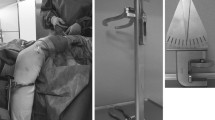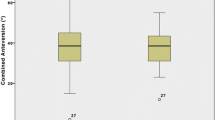Abstract
Purpose
In total hip arthroplasty (THA), combined anteversion (CA) is used as a parameter for assessment of overall prosthetic alignment. The purpose of this study was to comparatively examine the CA value in patients who underwent primary THA using the image-free navigation system either with a cup-first or stem-first technique.
Methods
Eighty-three hips undergoing primary THA using the OrthoPilot® image-free navigation system (B. Braun-Aesculap, Tuttlingen, Germany) were included in this study. The patient population was divided into two groups depending on the procedure used: cup-first technique and stem-first technique. In the cup-first group, inclination and anteversion (AV) angles were targeted at 35–45° and 15–25°, respectively, while stem antetorsion (AT) was determined for each patient based on the amount of individual native femoral AT angle. In the stem-first group, the femur was prepared first with the target angle corresponding to the native femoral AT and the cup AV was decided considering the CA calculated with Widmer’s formula (aiming at the optimal Widmer’s CA of 37.3°).
Results
Better consistency in Widmer’s CA values was attained in the stem-first group as indicated by the smaller SD values. In the assessment of overall alignment, Widmer’s CA values were within the satisfactory range (37 ± 5°) in 41.9 and 92.3 % of the subjects in the cup-first group and the stem-first group, respectively.
Conclusions
The stem-first technique with image-free navigated THA could effectively achieve accurate and consistent control of the CA value and thus is expected to improve the surgical outcome.


Similar content being viewed by others
References
Lewinnek GE, Lewis JL, Tarr R, Compere CL, Zimmerman JR (1978) Dislocations after total hip-replacement arthroplasties. J Bone Joint Surg Am 60(2):217–220
Wixson RL, MacDonald MA (2005) Total hip arthroplasty through a minimal posterior approach using imageless computer–assisted hip navigation. J Arthroplasty 20(7):51–56
Biedermann R, Tonin A, Krismer M, Rachbauer F, Eibl G, Stöckl B (2005) Reducing the risk of dislocation after total hip arthroplasty: the effect of orientation of the acetabular component. J Bone Joint Surg Br 87(6):762–769
Hayashi S, Nishiyama T, Fujishiro T, Hashimoto S, Kanzaki N, Nishida K, Kuroda R, Kurosaka M (2013) Evaluation of the accuracy of femoral component orientation by the CT-based fluoro-matched navigation system. Int Orthop 37(6):1063–1068
Widmer KH, Zurfluh B (2004) Compliant positioning of total hip components for optimal range of motion. J Orthop Res 22:815–821
Fukunishi S, Fukui T, Imamura F, Nishio S, Shibanuma N, Yoshiya S (2008) Assessment of accuracy of acetabular cup orientation in CT-free navigated total hip arthroplasty. Orthopedics 31:987
Fukui T, Fukunishi S, Nishio S, Shibanuma N, Yoshiya S (2010) Use of image-free navigation in determination of acetabular cup orientation: analysis of factors affecting precision. Orthopedics 33:38–42
Fukunishi S, Fukui T, Nishio S, Fujihara Y, Yoshiya S (2012) Combined anteversion of the total hip arthroplasty implanted with image-free cup navigation and without stem navigation. Orthop Rev (Pavia) 4:e33
Amuwa C, Dorr LD (2008) The combined anteversion technique for acetabular component anteversion. J Arthroplasty 23(7):1068–1070
Dorr LD, Malik A, Dastane M, Wan Z (2009) Combined anteversion technique for total hip arthroplasty. Clin Orthop Relat Res 467(1):119–127
Murray DW (1993) The definition and measurement of acetabular orientation. J Bone Joint Surg Br 75(2):228–232
Ranawac CS, Maynard MJ (1991) Modern techniques of cemented total hip arthroplasty. Tech Orthop 6(3):17–25
Jolles BM, Zangger P, Leyvraz PF (2002) Factors predisposing to dislocation after primary total hip arthroplasty: a multivariate analysis. J Arthroplasty 17(3):282–288
Yoshimine F (2006) The safe-zones for combined cup and neck anteversions that fulfill the essential range of motion and their optimum combination in total hip replacements. J Biomech 39:1315–1323
Hisatome T, Doi H (2011) Theoretically optimum position of the prosthesis in total hip arthroplasty to fulfill the severe range of motion criteria due to neck impingement. J Orthop Sci 16:229–237
Barsoum WK, Patterson RW, Higuera C, Klika AK, Krebs VE, Molloy R (2007) A computer model of the position of the combined component in the prevention of impingement in total hip replacement. J Bone Joint Surg Br 89(6):839–845
Shoji T, Yasunaga Y, Yamasaki T, Izumi S, Hachisuka S, Ochi M (2015) Low femoral antetorsion and total hip arthroplasty: a risk factor. Int Orthop 39(1):7–12
Wassilew GI, Perka C, Koenig K, Janz V, Asbach P, Hasart O (2010) 3D CT analysis of combined cup and stem anteversion in cases of cup navigation hip arthroplasty. Orthopedics 33:48–51
Sendtner E, Tibor S, Winkler R, Wörner M, Grifka J, Renkawitz T (2010) Stem torsion in total hip replacement. CT measurements in 60 patients. Acta Orthop 81(5):579–582
Wines AP, McNicol D (2006) Computed tomography measurement of the accuracy of component version in total hip arthroplasty. J Arthroplasty 21(5):696–701
Bargar WL, Jamali AA, Nejad AH (2010) Femoral anteversion in THA and its lack of correction with native acetabular anteversion. Clin Orthop Relat Res 468(2):527–532
Emerson RH (2012) Increased anteversion of press-fit femoral stems compared with anatomic femur. Clin Orthop Relat Res 470(2):477–481
Husmann O, Rubin PJ, Leyvraz PF, de Roguin B, Argenson JN (1997) Three-dimensional morphology of the proximal femur. J Arthroplasty 12(4):444–450
Dorr LD, Wan Z, Malik A, Zhu J, Dastane M, Deshmane P (2009) A comparison of surgeon estimation and computed tomographic measurement of femoral component anteversion in cementless total hip arthroplasty. J Bone Joint Surg Am 91(11):2598–2604
Kitada M, Nakamura N, Iwana D, Kakimoto A, Nishi T, Sugano N (2011) Evaluation of the accuracy of computed tomography-based navigation for femoral stem orientation and leg length discrepancy. J Arthroplasty 26(5):674–679
Sugano N, Noble PC, Kamaric E (1998) A comparison of alternative methods of measuring femoral anteversion. J Comput Assist Tomogr 22(4):610–614
Nakashima Y, Hirata M, Akiyama M, Itokawa T, Yamamoto T, Motomura G, Ohishi M, Hamai S, Iwamoto Y (2014) Combined anteversion technique reduced the dislocation in cementless total hip arthroplasty. Int Orthop 38(1):27–32
Zhang J, Wang L, Mao Y, Li H, Ding H, Zhu Z (2014) The use of combined anteversion in total hip arthroplasty for patients with developmental dysplasia of the hip. J Arthroplasty 29(3):621–625
Author information
Authors and Affiliations
Corresponding author
Rights and permissions
About this article
Cite this article
Fukunishi, S., Nishio, S., Fujihara, Y. et al. Accuracy of combined anteversion in image-free navigated total hip arthroplasty: stem-first or cup-first technique?. International Orthopaedics (SICOT) 40, 9–13 (2016). https://doi.org/10.1007/s00264-015-2784-9
Received:
Accepted:
Published:
Issue Date:
DOI: https://doi.org/10.1007/s00264-015-2784-9




